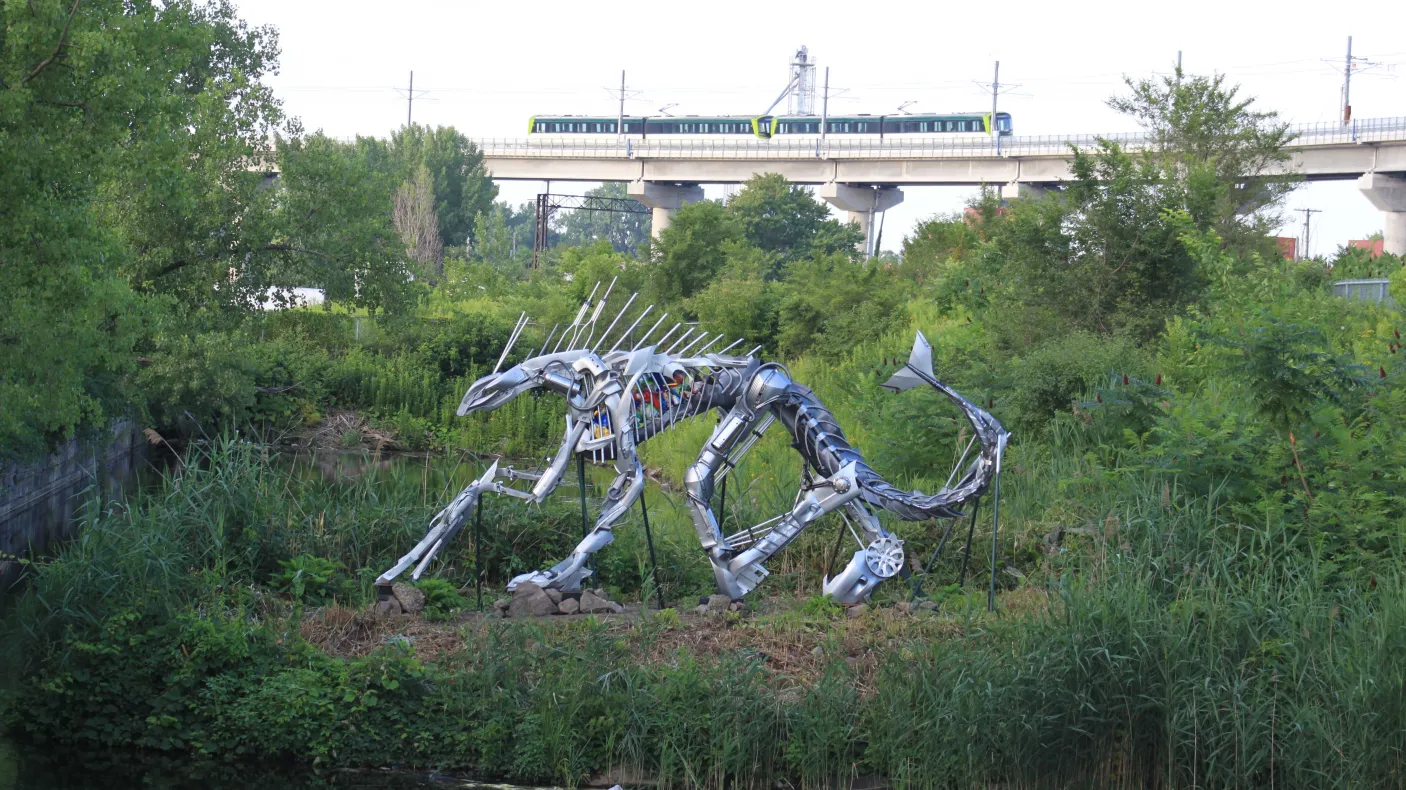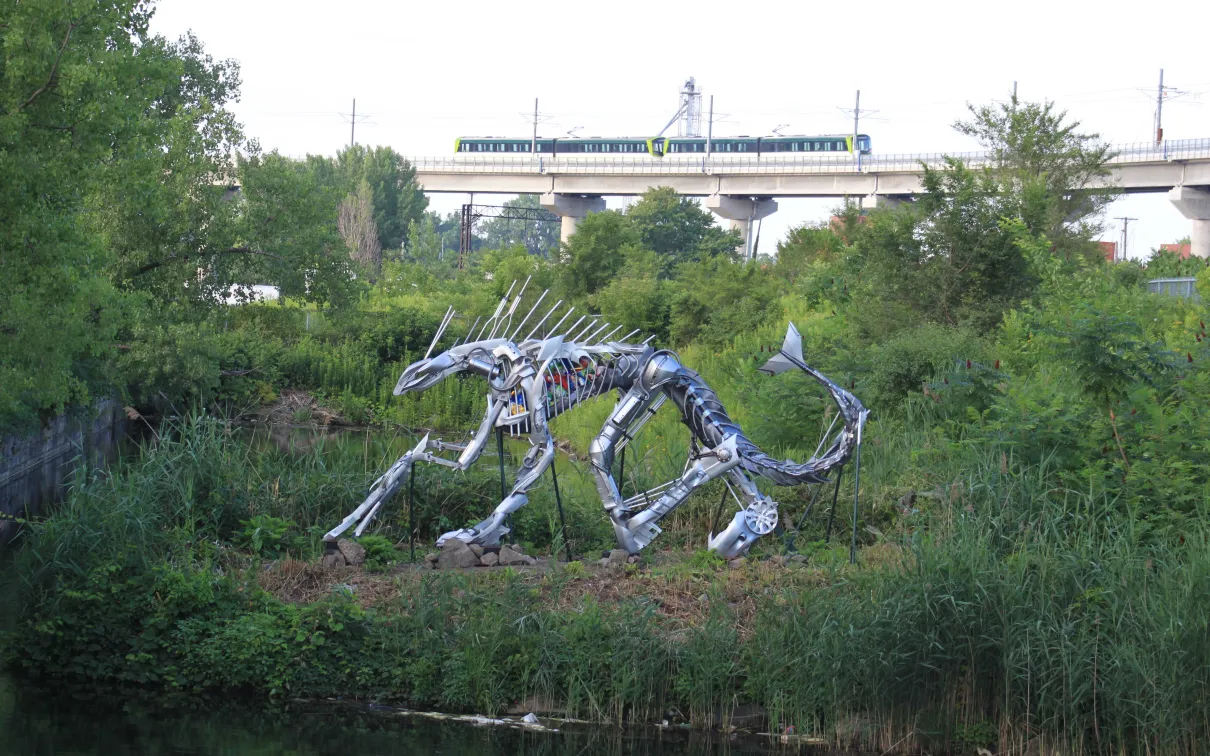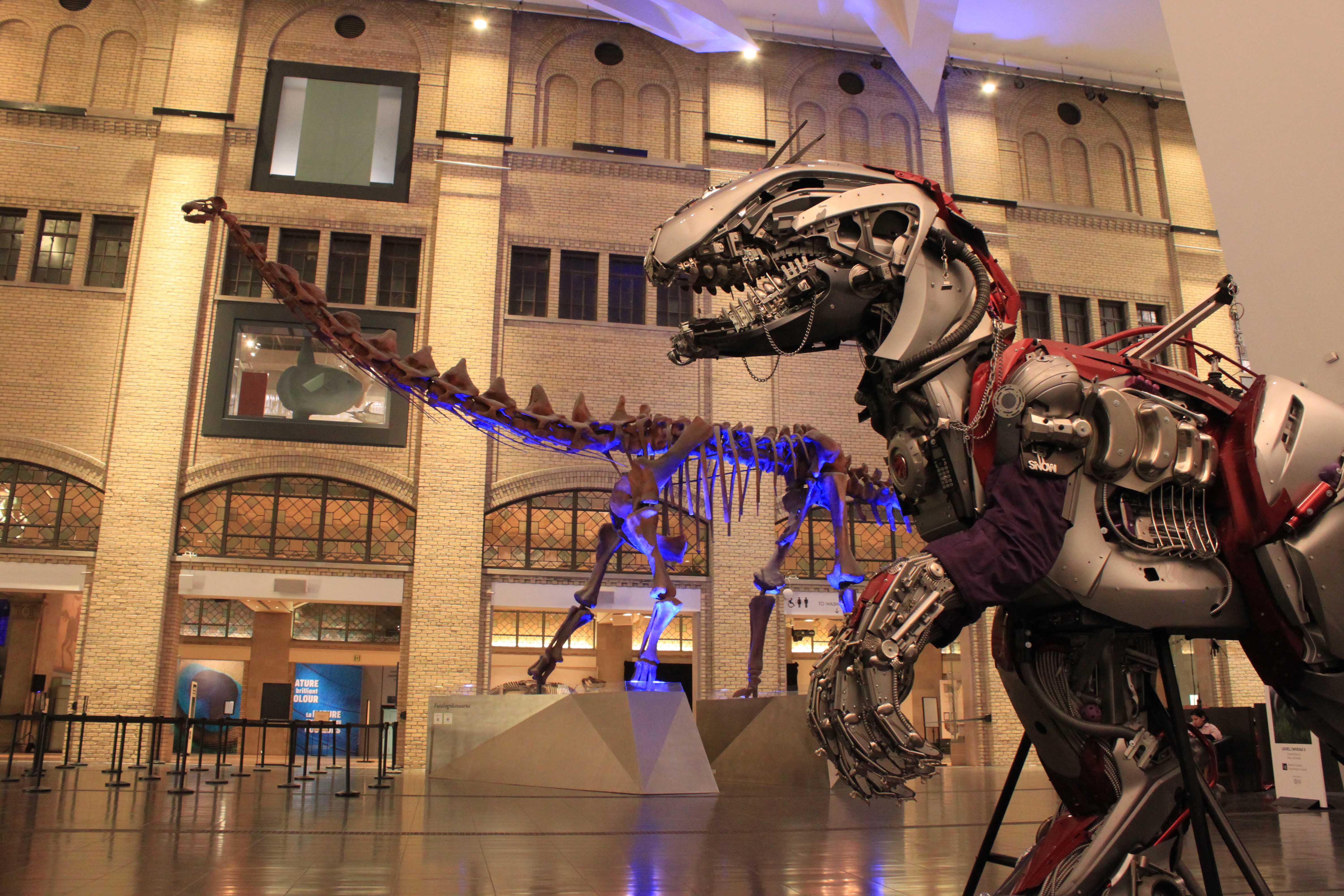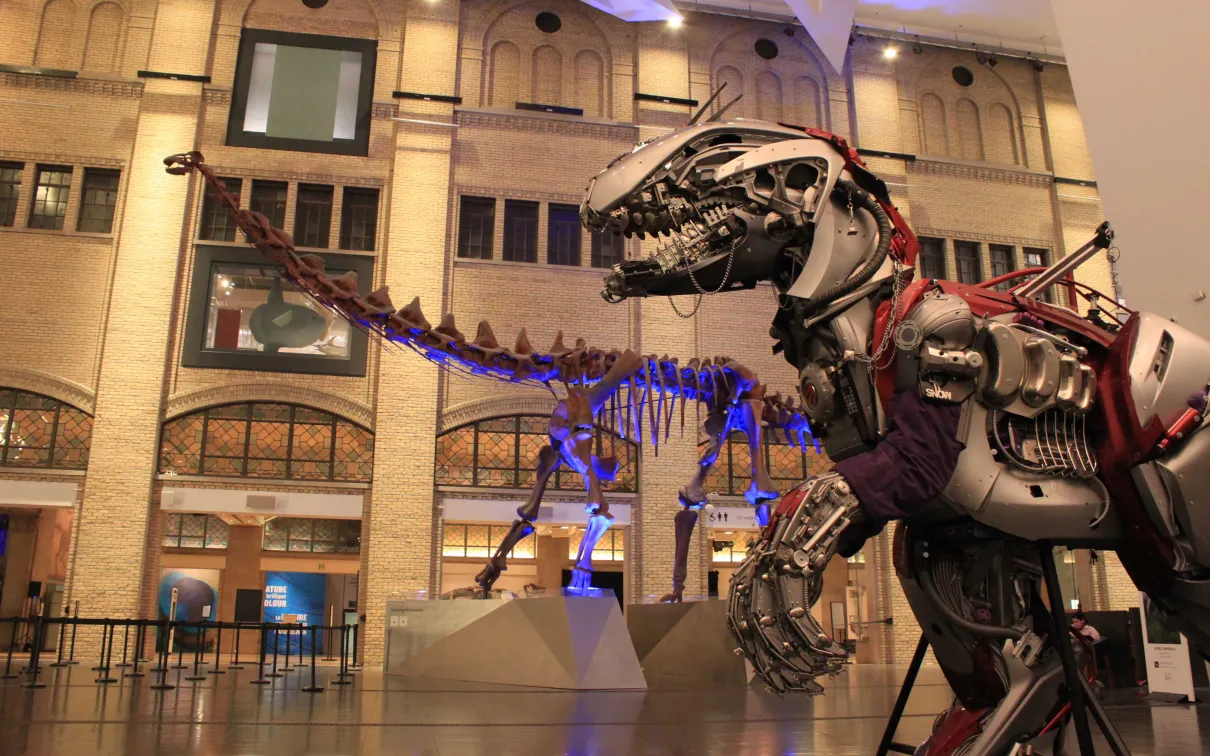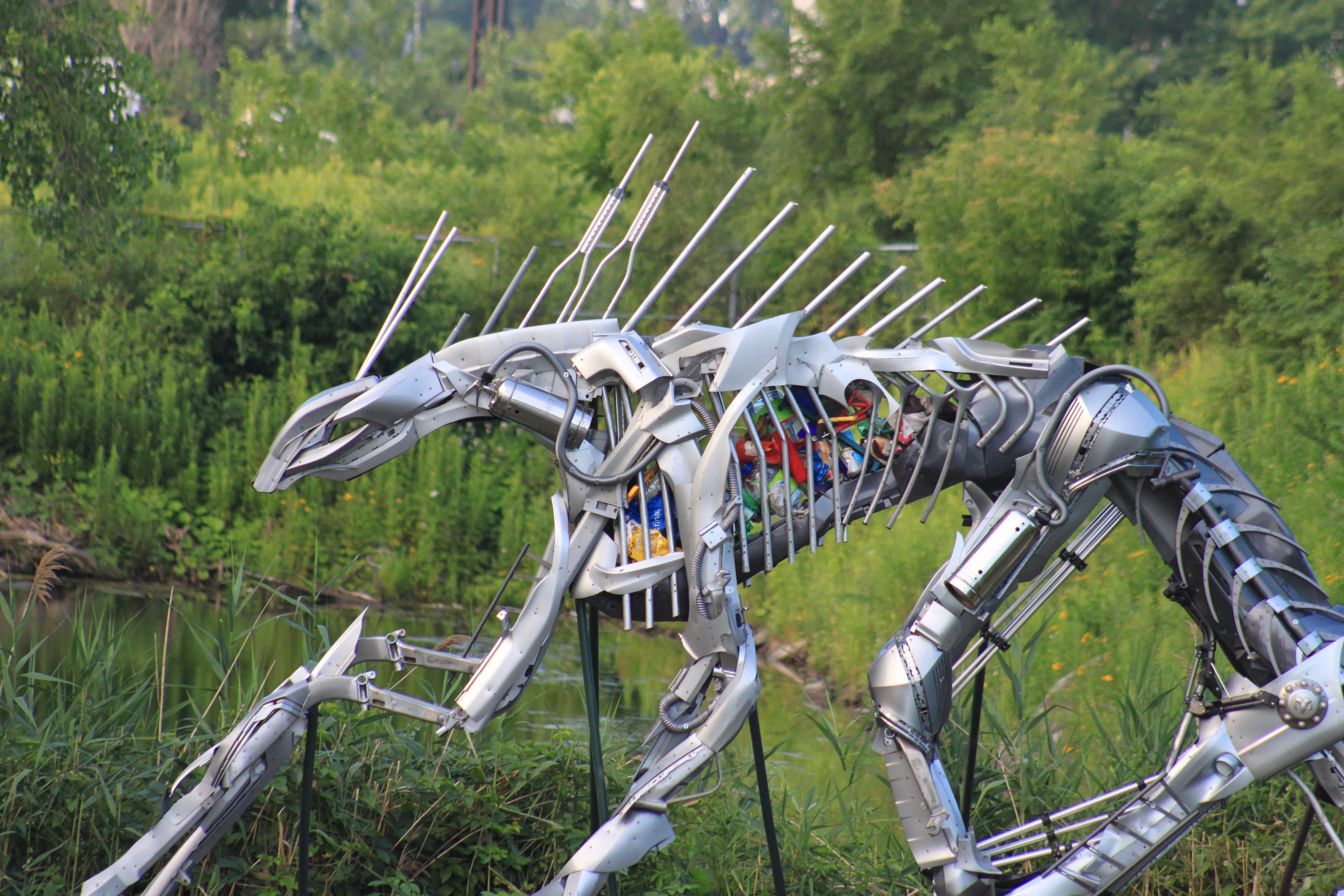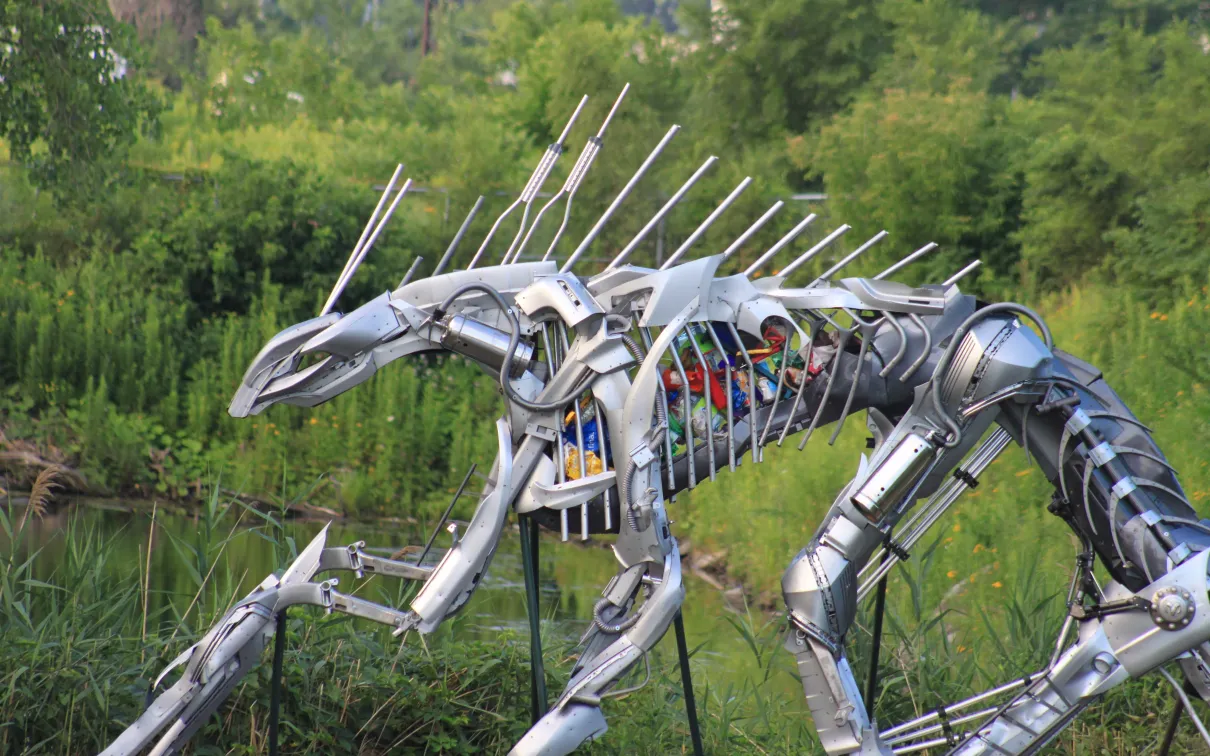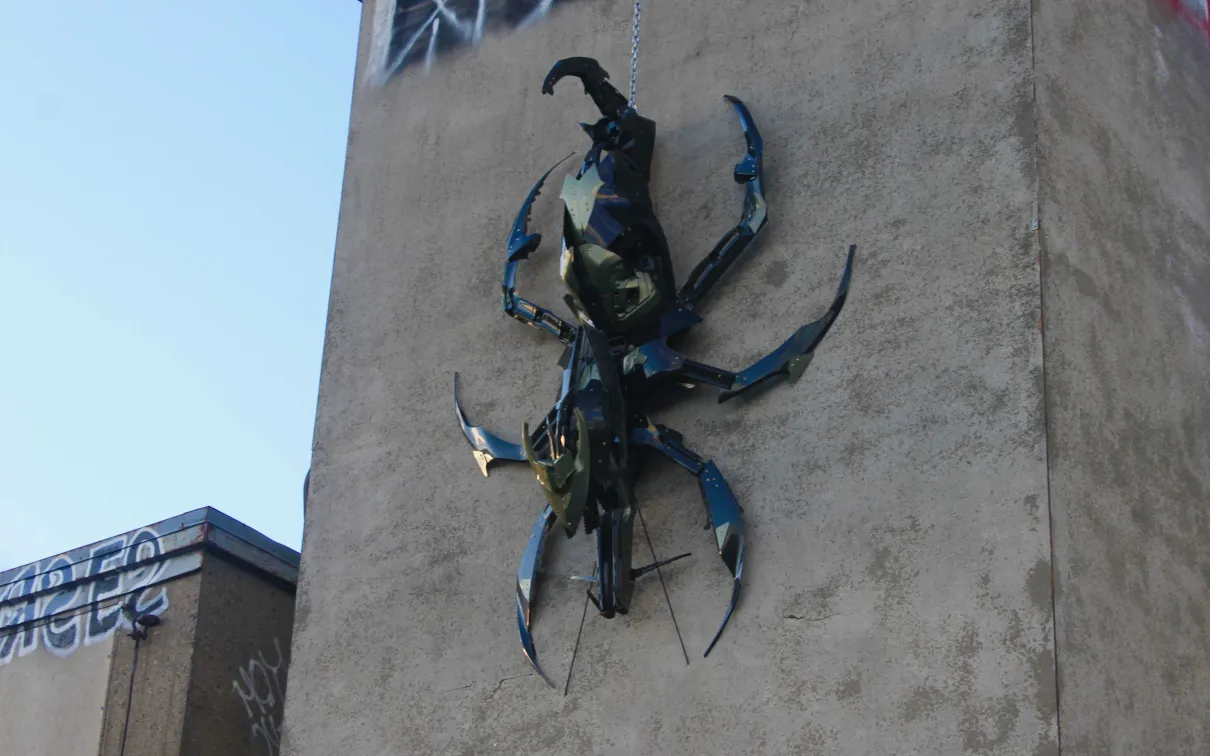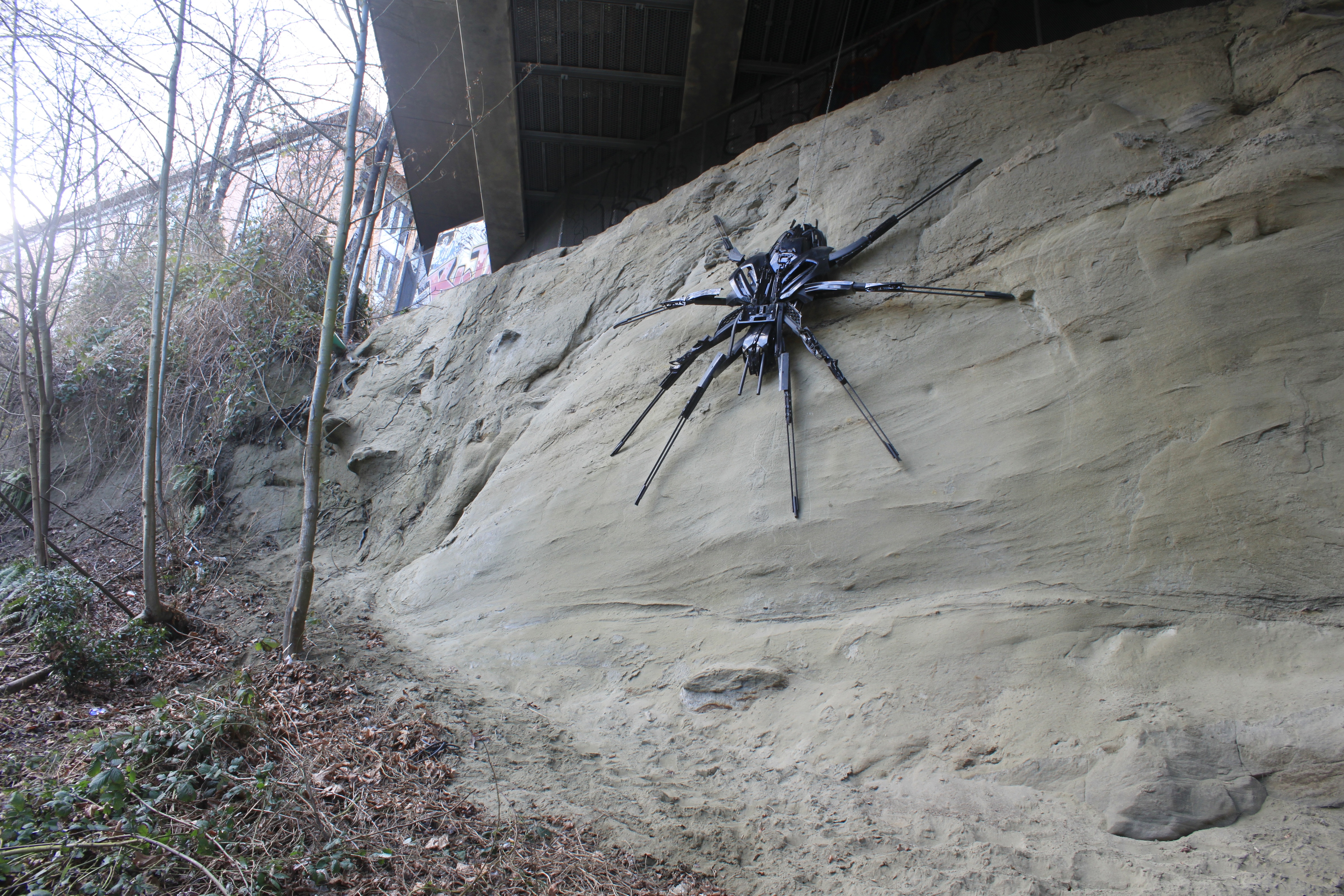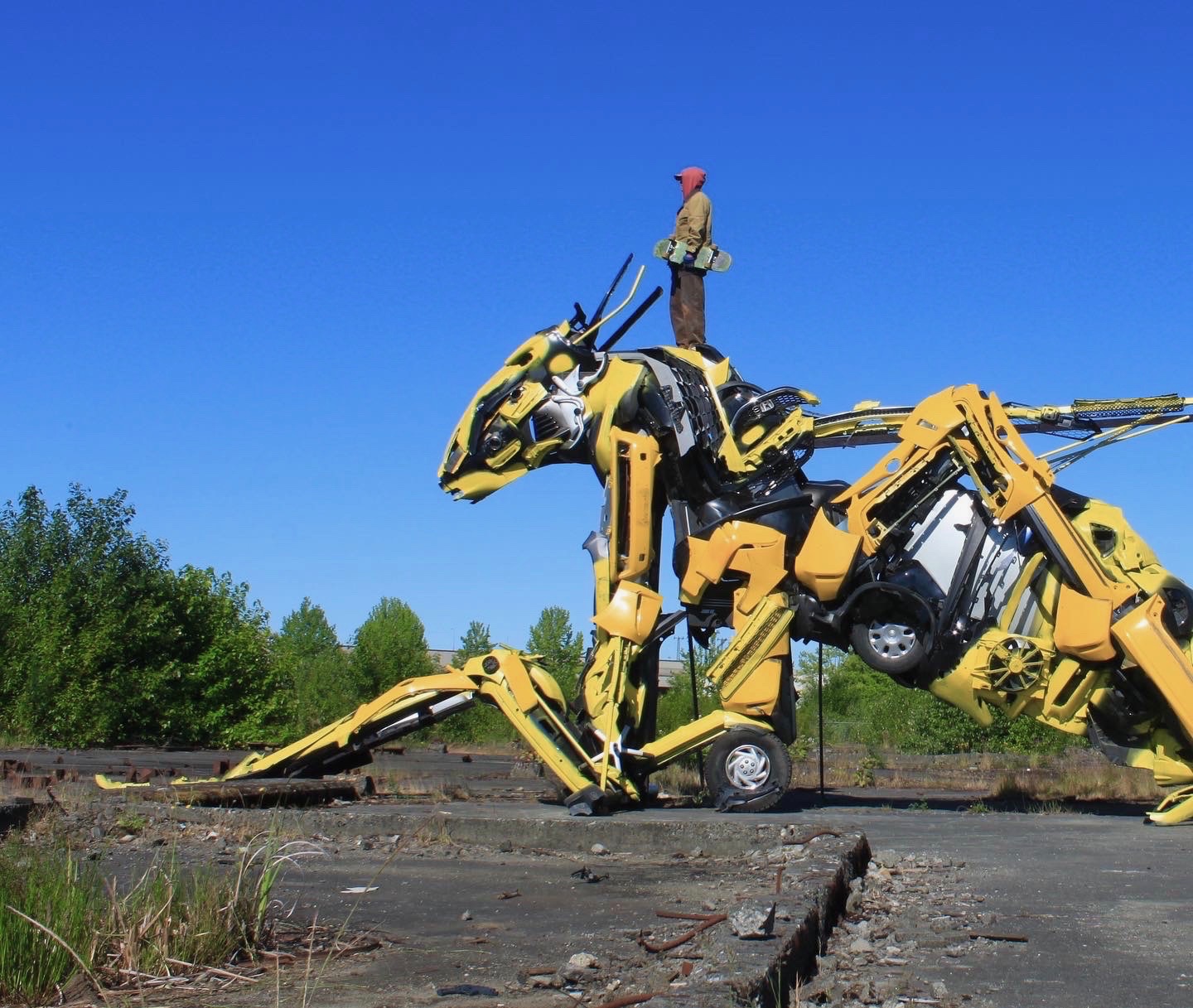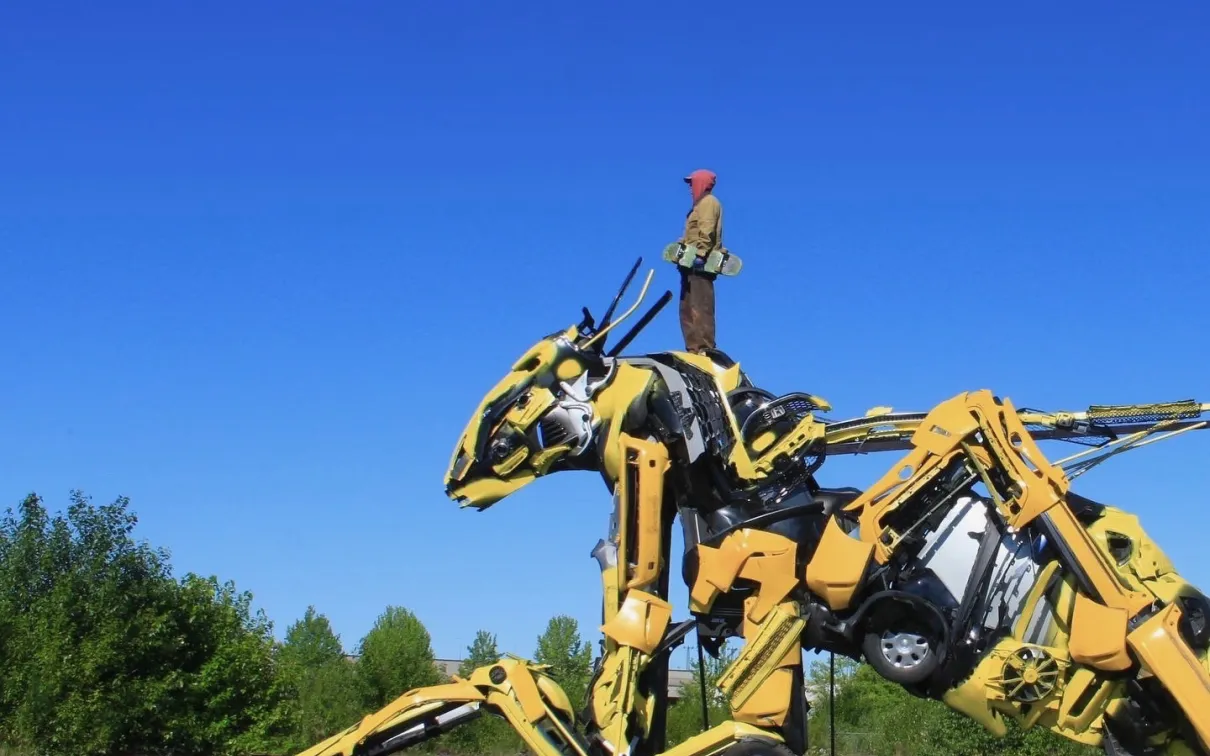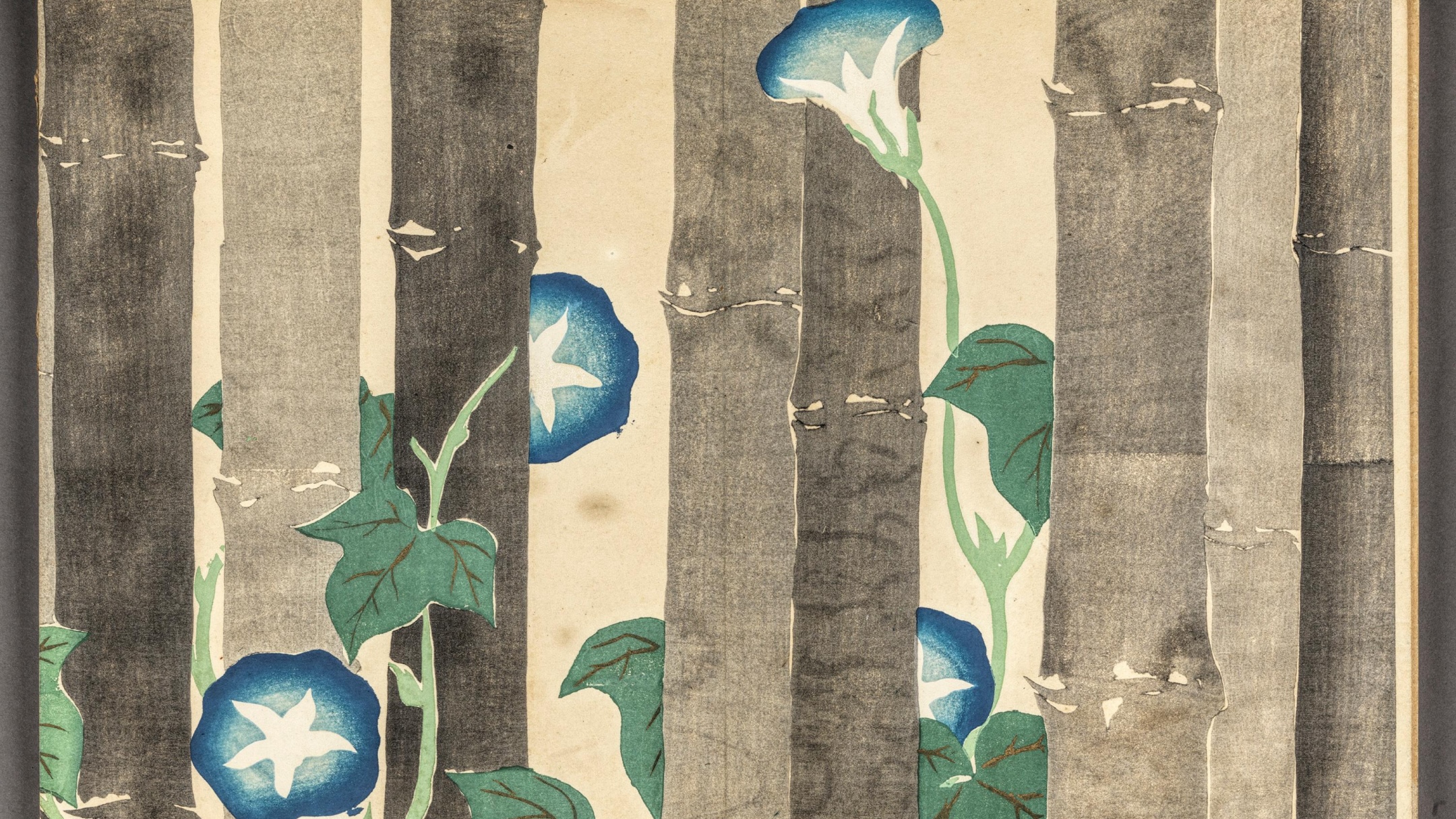Raptors, Spiders, and Fantastical Beasts in Public Art
An interview with street artist JUNKO on creating magic from recycled materials.
Published
Category
Author
Intro
There is a weird and wondrous creature looming in the halls of the Royal Ontario Museum this Family Day weekend. A velociraptor-like beast made up of metallic sinews and bold purple sleeves, it seems to have stepped out of a futuristic sequel to Jurassic Park—if it were directed by Micheal Bay. Not a transformer, not quite a raptor, the Recyclosaur is the newest creation by the Canadian street artist known only as JUNKO, who creates large-scale fantastical public art from recycled materials.
Be it a giant spider made of used windshield wipers in Vancouver or a phantasmagoric monster made from the remains of Bixi bikes on a street in Montreal, JUNKO's creatures, strategically placed within their Canadian environs, are a statement on our very human entanglements of disposability and belonging.
The Recyclosaur is a commissioned work by the beloved Toronto Raptors in partnership with the waste management company GFL Environmental Inc. With the metallic giant on special display for four days at ROM, we took the opportunity to connect with JUNKO on his awe-inspiring creations and the inspiration behind them.
Interview
Your sculptures bring with them a magical otherworldliness that connects us to a land of fantasy and imagination. How do you conceive of the "creature" that you'll ultimately create? Do you ever give them pet names?
This fascination with creatures sort of runs in my family. My dad has a collection of framed insects that hang on the wall and my uncle used to have a collection of live scorpions in his basement.
The first word I ever spoke as a child was “dinosaur”, which sums it up pretty good. My sister, my cousin, and I spent a lot of time drawing as kids, creating our own fantasy worlds, and what I do now is really just the evolution of that.
I’ve always enjoyed the act of creating something rather than recreating something. I’ll use existing animals or creatures as inspiration, but I never try to make an exact replica of something.
Generally, I just come up with a title for the piece, which sometimes also becomes a name for the creature. For this project with the Raptors and GFL, the title for the artwork is Recyclosaur, but my name for her is “Scarlet.”
How did you get started building these large-scale sculptures?
I’ve been making art my whole life. It all started with drawing dinosaurs and creatures which eventually evolved into drawings, paintings, large-scale murals, and street art etc. But always two-dimensional art. As a young adult, I worked a construction-based job for a number of years which eventually shifted my focus away from art and towards “eco” or “sustainable” construction. After gaining some building experience in this field, I returned to my art practice and with the skills I learned in construction, my art organically evolved into three-dimensional work.
My sculpture practice began around the time the pandemic started. I would go for walks and collect whatever discarded objects I could find in the streets and see what I could make with them. The first large-scale sculpture I built was outside the city. I went with my partner at the time to meet some artist friends at an abandoned factory far outside the city to camp out and create some art amongst the ruins of the factory. I had never been to this site, and when I arrived, I was blown away by the location.
There were these massive concrete chambers, each bigger than a basketball court, surrounded by tall concrete walls and without any roof, open to the sky. As soon as I saw the location I knew I wanted to create a sculpture there, and to do this epic location justice, it had to be massive.
I spent the following month making trips to the location, camping out in the forest close by and working on a giant sculpture. After completing this sculpture, I knew I was on to something special.
I don't ever feel the need to buy pieces because I don't have an exact vision of what the sculpture will look like. I plan out the shape of the sculpture but the materials I find end up dictating the final piece. It’s more of a process of me discovering what's possible.
QA
What is your creative process like? What comes first, the idea or the materials? Or is it sometimes the location?
For my street art installations, it’s always the location. Generally, I look for spaces that are neglected, spaces where trash and litter already tend to build up. Once I’ve settled on a location I begin to brainstorm and visualize an idea and how it could fit into the space.
My materials are always evolving. I started out collecting junk in the streets, which I still do, but now I’ve found sources for some of the waste materials that I like using. I really enjoy projects where someone approaches me with a waste material to work with.
A few years ago, I did a project for the Montreal MURAL festival in conjunction with BIXI, the Montreal Bike-sharing system. They asked me to create a sculpture that incorporated retired scrap bicycle parts.
The Recyclosaur project, between the Raptors and GFL Environmental, was sort of similar, only I got to go to a GFL recycling facility and choose from a variety of waste materials. It’s great because it forces me to experiment with new materials and try new things.
Does it get tricky repurposing salvaged materials?
I do occasionally use some new material in building the internal structure for my sculptures. The most important step is creating a skeleton that is structurally sound and safe to hold the amount of weight of all the objects and materials I will be attaching to it.
The structure is a crucial component of the whole piece, so if I’m unable to find enough reclaimed material to build it, I’ll use some new material. Also, what enables me to work with such a wide variety of materials is connecting pieces with mechanical fasteners, like screws, bolts, etc., so I buy a lot of hardware.
Regarding the waste material that covers the entire sculpture, the variety is seemingly endless and the more I do this, the more ways I figure out how to use different materials. Another reason I don't ever feel the need to buy pieces is because I don't have an exact vision or plan of what the sculpture will look like. I plan out the shape of the sculpture but the pieces and materials that I find and have available to me are what end up dictating the final sculpture.
Once the internal structure is complete, attaching all the different pieces is improvised and happens instinctively, so it’s more of a process of me discovering what's possible.
QA
What fascinates you most about the Recyclosaur?
This project was interesting because the sculpture is inspired by the raptor depicted in the original Raptors logo, which was influenced by the raptors in the original Jurassic Park movie that had just come out when the Raptors team was born, and the raptors in that movie were inaccurate depictions of what real velociraptors looked like. So in the end, especially after I added all my random sci-fi space junk to it, it looks nothing like a real velociraptor—what it’s supposed to be in theory.
The flashy chains and purple sleeves on the sculpture reference the colourful and loud fashion of the 90’s that gave birth to the Raptors identity.
What excites me most about this piece is all the new materials and techniques I used in creating it. On my first trip to the GFL recycling facility, I grabbed a variety of metal materials and wasn’t really sure which ones I would use or how. Amongst the pieces I grabbed were a few pieces of aluminum flexible conduit. I didn’t think much of them at first but once I was back in the studio, I came up with a way to use them to create sections of the sculpture that look like muscles or tendons. Once I figured that out, I rushed back to GFL to stock up on that one material.
Another first for me was the use of fabric in one of my sculptures. Although it's just a small touch, the purple sleeves, I find it has a strong impact in referencing the old-school raptors colours and jerseys.
For this sculpture, the creative team from the Raptors specifically asked me to include some purple in the sculpture. They suggested spray-painting some of the pieces of the sculpture. When I first started out making sculptures I used to paint them, but I quickly moved away from using spray paint as it contradicts the whole eco-friendly aspect of the work. I now use waste material that is already the colour I want so I don't have to paint any of it.
But finding cool-looking purple junk isn't easy, so it forced me to be creative. I basically just had my eyes open to anything I could find that was purple, and amidst my junk collecting excursions I came across a pair of purple snow pants. Prior to this sculpture I wouldn’t have even considered using fabric in one of my sculptures, but because I was so desperate for anything purple, I brainstormed how I could maybe use it. And it ended up being one of my favourite pieces on the sculpture.
Creating this piece has been an extremely meaningful experience for me. I grew up here in Toronto and to be invited back to my hometown for a project as big as this has really felt full circle and reconnected me with people and places from my youth. Collaborating with the Raptors on a dinosaur sculpture to be shown in ROM is really a dream project for me as an artist.
Why do you do it? Why is it important to you on a personal level to create art?
This is a tough one, creating art is the most prominent aspect of my life so it’s almost a question of my entire existence. To keep it short and simple, I do it because I love doing it and it fulfills me. Since I was a kid, drawing and making art has always just felt right, and now as an adult it gives me a great sense of purpose and pride.
When I’m not working towards a goal, I begin to feel a bit aimless and unsure. It challenges me physically and mentally and forces me to continue to learn new things. It’s my entire livelihood and has given me a reason to travel and meet new people. Now it’s also my career and what supports me financially, which makes me want to work even harder at it.
What keeps me inspired is progressing my craft, creating something and then reflecting on what I can do differently next time.
The only other activity in my life I can think of that fulfills so many different basic human needs for me is skateboarding. Just like my art practice, it keeps my mind and body healthy by challenging me physically and mentally and providing a social circle and sense of community.
The Recylosaur is on display in the Samuel Hall Currelly Gallery in ROM, courtesy of JUNKO, the Toronto Raptors, and GFL Environmental Inc.
